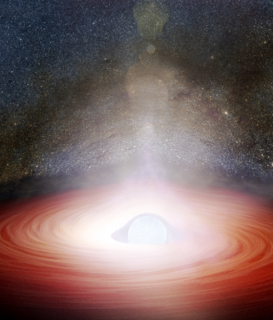
A neutron star is the collapsed core of a massive supergiant star, which had a total mass of between 10 and 25 solar masses, possibly more if the star was especially metal-rich. Except for black holes, and some hypothetical objects, neutron stars are the smallest and densest currently known class of stellar objects. Neutron stars have a radius on the order of 10 kilometres (6.2 mi) and a mass of about 1.4 solar masses. They result from the supernova explosion of a massive star, combined with gravitational collapse, that compresses the core past white dwarf star density to that of atomic nuclei.

A supernova is a powerful and luminous stellar explosion. This transient astronomical event occurs during the last evolutionary stages of a massive star or when a white dwarf is triggered into runaway nuclear fusion. The original object, called the progenitor, either collapses to a neutron star or black hole, or is completely destroyed. The peak optical luminosity of a supernova can be comparable to that of an entire galaxy before fading over several weeks or months.

In gamma-ray astronomy, gamma-ray bursts (GRBs) are immensely energetic explosions that have been observed in distant galaxies. They are the brightest and most energetic electromagnetic events known to occur in the universe. Bursts can last from ten milliseconds to several hours. After an initial flash of gamma rays, a longer-lived "afterglow" is usually emitted at longer wavelengths.
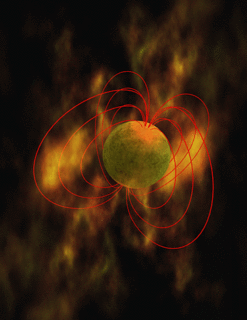
A magnetar is a type of neutron star believed to have an extremely powerful magnetic field (∼109 to 1011 T, ∼1013 to 1015 G). The magnetic-field decay powers the emission of high-energy electromagnetic radiation, particularly X-rays and gamma rays. The theory regarding these objects was proposed in 1992 by Robert Duncan and Christopher Thompson. The theory was subsequently developed by Bohdan Paczyński and by its proposers. This theory explained a burst of gamma rays from the Large Magellanic Cloud that had been detected on March 5, 1979, and other less bright bursts from within our galaxy. During the following decade, the magnetar hypothesis became widely accepted as a likely explanation for soft gamma repeaters (SGRs) and anomalous X-ray pulsars (AXPs). In 2020, a fast radio burst (FRB) was detected from a magnetar.
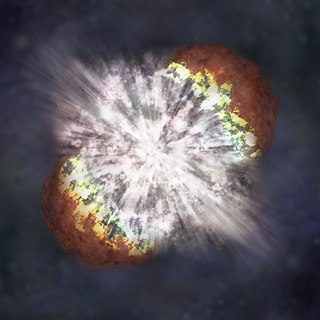
A super-luminous supernova is a type of stellar explosion with a luminosity 10 or more times higher than that of standard supernovae. Like supernovae, SLSNe seem to be produced by several mechanisms, which is readily revealed by their light-curves and spectra. There are multiple models for what conditions may produce an SLSN, including core collapse in particularly massive stars, millisecond magnetars, interaction with circumstellar material, or pair-instability supernovae.

The Fermi Gamma-ray Space Telescope (FGST), formerly called the Gamma-ray Large Area Space Telescope (GLAST), is a space observatory being used to perform gamma-ray astronomy observations from low Earth orbit. Its main instrument is the Large Area Telescope (LAT), with which astronomers mostly intend to perform an all-sky survey studying astrophysical and cosmological phenomena such as active galactic nuclei, pulsars, other high-energy sources and dark matter. Another instrument aboard Fermi, the Gamma-ray Burst Monitor, is being used to study gamma-ray bursts and solar flares.
In astroparticle physics, an ultra-high-energy cosmic ray (UHECR) is a cosmic ray with an energy greater than 1 EeV (1018 electronvolts, approximately 0.16 joules), far beyond both the rest mass and energies typical of other cosmic ray particles.
A stellar black hole is a black hole formed by the gravitational collapse of a star. They have masses ranging from about 5 to several tens of solar masses. The process is observed as a hypernova explosion or as a gamma ray burst. These black holes are also referred to as collapsars.
An astrophysical jet is an astronomical phenomenon where outflows of ionised matter are emitted as an extended beam along the axis of rotation. When this greatly accelerated matter in the beam approaches the speed of light, astrophysical jets become relativistic jets as they show effects from special relativity.
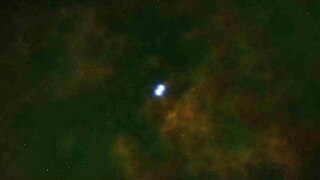
A type Ia supernova is a type of supernova that occurs in binary systems in which one of the stars is a white dwarf. The other star can be anything from a giant star to an even smaller white dwarf.

A Type II supernova results from the rapid collapse and violent explosion of a massive star. A star must have at least 8 times, but no more than 40 to 50 times, the mass of the Sun (M☉) to undergo this type of explosion. Type II supernovae are distinguished from other types of supernovae by the presence of hydrogen in their spectra. They are usually observed in the spiral arms of galaxies and in H II regions, but not in elliptical galaxies; those are generally composed of older low-mass stars, with few of the young highly massive stars necessary to cause a supernova.
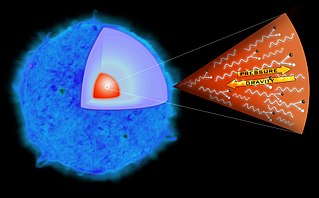
A pair-instability supernova is a type of supernova predicted to occur when pair production, the production of free electrons and positrons in the collision between atomic nuclei and energetic gamma rays, temporarily reduces the internal radiation pressure supporting a supermassive star's core against gravitational collapse. This pressure drop leads to a partial collapse, which in turn causes greatly accelerated burning in a runaway thermonuclear explosion, resulting in the star being blown completely apart without leaving a stellar remnant behind.
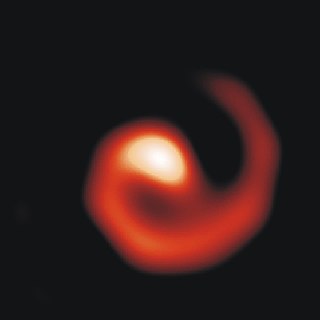
WR 104 is a triple star system located about 2,580 parsecs (8,400 ly) from Earth. The primary star is a Wolf–Rayet star, abbreviated as WR, with a B0.5 main sequence star in close orbit and another more distant fainter companion.

A neutron star merger is a type of stellar collision. It occurs in a fashion similar to the rare brand of type Ia supernovae resulting from merging white dwarfs.

A kilonova is a transient astronomical event that occurs in a compact binary system when two neutron stars or a neutron star and a black hole merge into each other. Kilonovae are thought to emit short gamma-ray bursts and strong electromagnetic radiation due to the radioactive decay of heavy r-process nuclei that are produced and ejected fairly isotropically during the merger process.
Multi-messenger astronomy is astronomy based on the coordinated observation and interpretation of disparate "messenger" signals. Interplanetary probes can visit objects within the Solar System, but beyond that, information must rely on "extrasolar messengers". The four extrasolar messengers are electromagnetic radiation, gravitational waves, neutrinos, and cosmic rays. They are created by different astrophysical processes, and thus reveal different information about their sources.

A hypernova is a very energetic supernova thought to result from an extreme core-collapse scenario. In this case, a massive star collapses to form a rotating black hole emitting twin energetic jets and surrounded by an accretion disk. It is a type of stellar explosion that ejects material with an unusually high kinetic energy, an order of magnitude higher than most supernovae, with a luminosity at least 10 times greater. They usually appear similar to a type Ic supernova, but with unusually broad spectral lines indicating an extremely high expansion velocity. Hypernovae are one of the mechanisms for producing long gamma ray bursts (GRBs), which range from 2 seconds to over a minute in duration. They have also been referred to as superluminous supernovae, though that classification also includes other types of extremely luminous stellar explosions that have different origins.

GW 170817 was a gravitational wave (GW) signal observed by the LIGO and Virgo detectors on 17 August 2017, originating from the shell elliptical galaxy NGC 4993. The GW was produced by the last minutes of two neutron stars spiralling closer to each other and finally merging, and is the first GW observation which has been confirmed by non-gravitational means. Unlike the five previous GW detections, which were of merging black holes not expected to produce a detectable electromagnetic signal, the aftermath of this merger was also seen by 70 observatories on 7 continents and in space, across the electromagnetic spectrum, marking a significant breakthrough for multi-messenger astronomy. The discovery and subsequent observations of GW 170817 were given the Breakthrough of the Year award for 2017 by the journal Science.

NGC 4993 is a lenticular galaxy located about 140 million light-years away in the constellation Hydra. It was discovered on 26 March 1789 by William Herschel and is a member of the NGC 4993 Group.
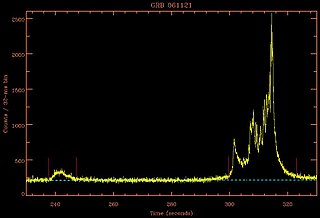
A gamma-ray precursor is a short X-ray outburst event that comes before the main outburst of the gamma-ray burst progenitor. There is no consensus on the mechanism for this event, although several theories have been suggested.























